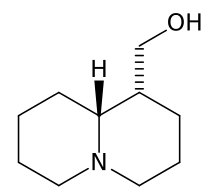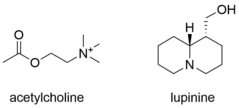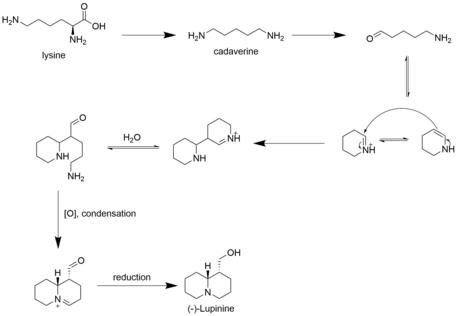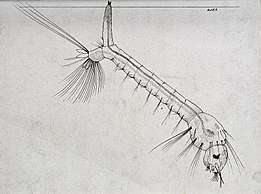Lupinine
Lupinine is a quinolizidine alkaloid present in the genus Lupinus (colloquially referred to as lupins) of the flowering plant family Fabaceae.[1] The scientific literature contains many reports on the isolation and synthesis of this compound as well as a vast number of studies on its biosynthesis from its natural precursor, lysine.[2][3] Studies have shown that lupinine hydrochloride is a mildly toxic acetylcholinesterase inhibitor and that lupinine has an inhibitory effect on acetylcholine receptors.[4][5] The characteristically bitter taste of lupin beans, which come from the seeds of Lupinus plants, is attributable to the quinolizidine alkaloids which they contain, rendering them unsuitable for human and animal consumption unless handled properly.[6][7] However, because lupin beans have potential nutritional value due to their high protein content,[8] efforts have been made to reduce their alkaloid content through the development of "sweet" varieties of Lupinus.[9][10]
 | |
| Names | |
|---|---|
| IUPAC name
[(1R,9aR)-2,3,4,6,7,8,9,9a-Octahydro-1H-quinolizin-1-yl]methanol | |
| Identifiers | |
3D model (JSmol) |
|
| 3DMet | |
| ChEBI | |
| ChEMBL | |
| ChemSpider | |
| ECHA InfoCard | 100.006.944 |
| EC Number |
|
| KEGG | |
PubChem CID |
|
| UNII | |
CompTox Dashboard (EPA) |
|
| |
| |
| Properties | |
| C10H19NO | |
| Molar mass | 169.268 g·mol−1 |
| Melting point | 68 to 69 °C (154 to 156 °F; 341 to 342 K) |
| Boiling point | 269 to 270 °C (516 to 518 °F; 542 to 543 K) |
| Hazards | |
| GHS pictograms |  |
| GHS Signal word | Warning |
GHS hazard statements |
H302, H312, H332 |
| P261, P264, P270, P271, P280, P301+312, P302+352, P304+312, P304+340, P312, P322, P330, P363, P501 | |
Except where otherwise noted, data are given for materials in their standard state (at 25 °C [77 °F], 100 kPa). | |
| Infobox references | |
Toxicity
Lupinine is a hepatotoxin prevalent in the seeds of leguminous herbs of the genus Lupinus.[9] Lupinine and other quinolizidine alkaloids give a bitter taste to naturally growing lupin flowers.[5] Due to the toxicity of quinolizidine alkaloids, lupin beans are soaked overnight and rinsed to remove some of their alkaloid content.[7] However, when the cooking and rinsing procedure is insufficient, 10 grams of seeds are able to liberate as much as 100 milligrams of lupinine.[11]
The neurotoxicity of lupinine has been known within veterinary medical circles for some time due to the use of lupins as a forage feed for grazing livestock since it has high protein content.[9] It is found to produce lupinosis, which is a morbid, and often fatal condition that results in acute atrophy of liver function and which affects domestic animals such as cattle and sheep.[9] When ingested by humans, quinolizidine alkaloid poisoning causes trembling, shaking, excitation, as well as convulsions.[12] Lupinine, in addition to being orally toxic to mammals, is also an insect antifeedant as well as a growth inhibitor for the grasshopper.[13]
Relative toxicity

Lupinine, in comparison to other quinolizidine alkaloids commonly found in lupins, such as lupanine and sparteine, shows a lower toxicity. Lupinine, with a minimal lethal dose of 28–30 mg/kg and a toxic dose of 25–28 mg/kg, is about 85 percent as toxic as d-lupanine and about 90% as toxic as sparteine. The relative toxicity of lupinine with other quinolizidine alkaloids commonly found in lupins is shown in the table below.[14]
| Substance | Minimal Lethal Dose (mg/Kg)[14] | Toxic Dose (mg/Kg)[14] |
| Lupinine | 28-30 | 25-28 |
| Lupanine | 22-25 | 21-24 |
| Sparteine | 23-30 | 21-31 |
Mechanism of action

Studies on the hydrochloride of lupinine have shown it to be a reversible inhibitor of acetylcholinesterases.[4] Lupinine, a nitrogen-containing heterocycle, has a structure similar to the ammonium "head" of the acetylcholinesterase endogenous agonist, acetylcholine.[15] At physiological pH, the amine of lupinine is protonated which leads to ion-ion interaction with the acetylcholinesterase anionic site in the same manner as the ammonium on acetylcholine interacts.[15] Previous studies of reversible onium inhibitors similar to lupinine have shown that the ammonium groups (corresponding to the protonated amine of lupinine) enter the gorge of the active center of the acetylcholinesterase in the region of the Trp84 residue.[4] This leads to the formation of an enzyme-sorption complex with the anionic portion of the acetylcholinesterase located on the active site of lupinine, namely the amine.[15] This complex blocks the access of acetylcholine to the active center which decreases the catalytic hydrolysis and subsequent breakdown of acetylcholine by acetylcholinesterase.[15] Enzyme inactivation leads to an accumulation of acetylcholine in the body, hyperstimulation of both the muscarinic and nicotinic acetylcholine receptors, as well as subsequent disruption of neurotransmission.[16] However, it was found that the time of incubation did not affect the inhibition, leading to the conclusion that lupinine is a reversible inhibitor.[4]
Studies have also shown that lupinine has a binding affinity for both muscarinic and nicotinic acetylcholine receptors. Lupinine was found to have an IC50 value of >500 μM for nicotinic receptors and an IC50 value of 190 μM for muscarinic receptors. However, it has yet to be determined whether this affinity is agonistic or antagonistic in nature.[17]
Synthesis

Biological
Lupinine is naturally biosynthesized from l-lysine in the Lupinus genes of plants along with various other quinolizidine alkaloids. In the biosynthetic process, lysine is first decarboxylated into cadaverine, which is then oxidatively deaminated to the corresponding aldehyde. The aldehyde is then spontaneously cyclized into two tautmers which couple through an aldol type mechanism in which the allylic amine attacks the iminium, forming a dissymmetric dimeric intermediate which is then hydrated. The primary amine is then oxidized and an intramolecular condensation occurs, giving the quinolizidinealdehyde. The aldehyde is then reduced to an alcohol, giving, enantioselectively, (-)- lupinine.[3][18]
Synthetic
Lupinine has a chiral carbon atom; therefore, total syntheses of lupinine need to be enantioselective for (-)-lupinine in order to provide the biologically active product. The first racemic total synthesis of lupinine occurred in 1937 by Clemo, Morgan, and Raper.[19] Six more total syntheses of lupinine followed between 1940-1956, with the first enantioselective synthesis of lupinine occurring in 1966 by Goldberg and Ragade.[2] Since that initial enantioselective synthesis, there have been numerous total syntheses of both enantio-pure and racemic lupinine. One synthesis, notable because it describes the preparation of all four stereoisomers of lupinine, and containing many references to earlier work in this field, was published by Ma and Ni.[20] Another total synthesis of specific note due to the enantioselectivity and limited number of steps is by Santos et al. In 2010, Santos et al. synthesized enantioselective (-)- lupinine in 36% yield over eight steps using a double Mitsunobu Reaction.[21] First, they employed asymmetric addition of the starting materials using a Lewis acid, followed by treatment with a reducing agent and a base. This gave the (R,R)-alcohol. This configuration was inverted using a Mitsunobu reaction followed by hydrolysis, affording the (R,S) configuration of the alcohol. The alcohol was then reduced with alane, underwent another Mitsunobu reaction, was hydrolyzed to the acid and finally reduced to (-)-lupinine via alane reduction.[21]

Isolation
One of the earliest isolations of lupinine, from Lupinus palmeri collected in Utah, USA, is that reported by Couch, who was able to obtain crystalline lupinine without the use of chromatographic techniques.[22]
Applications

Pest control
Lupinine is an insect antifeedant.[13] Studies of its insecticide activity have shown it to be effective against culicine mosquito larvae which are vectors for viruses, filarial worms, and avian malaria.[23][24]
Botany
Lupins are often found growing with Castilleja (Indian paintbrush) which uses lupins as a host and confers lupinine and other alkaloids to itself. This works in tandem with the increase in nitrogen fixation to increase parasitic reproduction rates and potentially reduce herbivory activity; however, studies have shown mixed results in the efficacy of alkaloid transfer in prevention of herbivory activity.[25]
Pre-clinical
It has been found that lupinine shows moderate antiglycation activity with an IC50 value of 7.12.176 ± 7.745 μM in vitro. Protein glycation is one of the main causes of late stage diabetic complications. In this process, proteins and sugars couple, leading to the formation of advanced glycation end-products which alter the structure and function of the proteins. The end-products lead to damage within most vital organs including nephropathy of the kidney and nerves, cataracts in the eyes, and atherosclerosis of the blood vessels which leads to impaired wound healing. This glycation process naturally increases with old age and is a well-known cause of pre-mature aging. The key therapeutic approach to prevention of this process is inhibition of the end-product formation which has been found to be facilitated by lupinine. It is hypothesized that the amine of lupinine may interact with the sugar, making it unavailable for binding with the protein. It was also found that lupinine lacks cytoxicity and therefore could function as a safe and effective antiglycation agent. However, since these findings are pre-clinical and have not been reproduced, they may not translate consistently into clinical effects on people and future studies are necessary to determine the efficacy of lupinine in preventing protein glycation in humans.[26]
Regulations
The European Chemicals Agency (ECA) labels lupinine under the hazard statement codes H302, H312, and H332, which indicate that lupinine is harmful if swallowed, harmful in contact with skin, and harmful if inhaled, respectively. It is given a GHS07 labeling which indicates its acute oral toxicity is category 4.[27]
See also
- Lupin poisoning
- Sparteine
References
- Wink, Michael; Meißner, Carsten; Witte, Ludger (January 1995). "Patterns of quinolizidine alkaloids in 56 species of the genus Lupinus". Phytochemistry. 38 (1): 139–153. doi:10.1016/0031-9422(95)91890-d. ISSN 0031-9422.
- Goldberg, Stanley I.; Ragade, Indukanth (April 1967). "A total synthesis of optically active lupinine without benefit of resolution". The Journal of Organic Chemistry. 32 (4): 1046–1050. doi:10.1021/jo01279a039. ISSN 0022-3263. PMID 6042140.
- Golebiewski, W. Marek; Spenser, Ian D. (1985-10-01). "Biosynthesis of the lupine alkaloids. I. Lupinine". Canadian Journal of Chemistry. 63 (10): 2707–2718. doi:10.1139/v85-450. ISSN 0008-4042.
- Rozengart, E. V.; Basova, N. E. (2001-11-01). "Ammonium Compounds with Localized and Delocalized Charge as Reversible Inhibitors of Cholinesterases of Different Origin". Journal of Evolutionary Biochemistry and Physiology. 37 (6): 604–610. doi:10.1023/A:1014414126143. ISSN 0022-0930.
- Risikobewertung, Bundesinstitut Für (2017). "Risk assessment of the occurrence of alkaloids in lupin seeds" (PDF). OpenAgrar. doi:10.17590/20170530-142504. Cite journal requires
|journal=(help) - Bleitgen, R.; Gross, R.; Gross, U. (1979-06-01). "Die Lupine — ein Beitrag zur Nahrungsversorgung in den Anden". Zeitschrift für Ernährungswissenschaft (in German). 18 (2): 104–111. doi:10.1007/BF02023724. ISSN 0044-264X.
- Róbertsdóttir, Anna Rósa (2016). Icelandic herbs and their medicinal uses. Berkeley, California. ISBN 9781623170226. OCLC 910979700.
- Yáñez, Enrique; Ivanović, D.; Owen, D.F.; Ballester, D. (1983). "Chemical and Nutritional Evaluation of Sweet Lupines". Annals of Nutrition and Metabolism. 27 (6): 513–520. doi:10.1159/000176728. ISSN 1421-9697. PMID 6651228.
- Introduction to neurobehavioral toxicology : food and environment. Niesink, Raymundus Johannes Maria, 1953-. Boca Raton: CRC Press. 1999. ISBN 978-0849378027. OCLC 39764034.CS1 maint: others (link)
- Torres Tello, F.; Nagata, A.; Dreifuss Spiegel, W. (June 1980). "[Methods of eliminating alkaloids from the seeds of Lupinus mutabilis Sweet]". Archivos Latinoamericanos de Nutricion. 30 (2): 200–209. ISSN 0004-0622. PMID 7212919.
- Kirkensgaard, Kristine (2017-12-11). "Lupinine - the chemical stopping you from eating Lupin". natoxaq.ku.dk. Retrieved 2018-04-27.
- Resta, Donatella; Boschin, Giovanna; D'Agostina, Alessandra; Arnoldi, Anna (2008). "Evaluation of total quinolizidine alkaloids content in lupin flours, lupin-based ingredients, and foods". Molecular Nutrition & Food Research. 52 (4): 490–495. doi:10.1002/mnfr.200700206. ISSN 1613-4125. PMID 18324702.
- Dictionary of plant toxins. Harborne, J. B. (Jeffrey B.), Baxter, Herbert, 1928-, Moss, Gerard P. Chichester: Wiley. 1996. ISBN 978-0471951070. OCLC 34281328.CS1 maint: others (link)
- Couch, James (1926). "Relative Toxicity of the Lupine Alkaloids". Journal of Agricultural Research. XXXII: 51–67.
- Tilyabaev, Z.; Abduvakhabov, A. A. (1998-05-01). "Alkaloids ofAnabasis aphylla and their cholinergic activities". Chemistry of Natural Compounds. 34 (3): 295–297. doi:10.1007/BF02282405. ISSN 0009-3130.
- Colovic, Mirjana B.; Krstic, Danijela Z.; Lazarevic-Pasti, Tamara D.; Bondzic, Aleksandra M.; Vasic, Vesna M. (2013-04-01). "Acetylcholinesterase Inhibitors: Pharmacology and Toxicology". Current Neuropharmacology. 11 (3): 315–335. doi:10.2174/1570159x11311030006. PMC 3648782. PMID 24179466.
- Schmeller, Thorsten; Sauerwein, Martina; Sporer, Frank; Wink, Michael; Müller, Walter E. (September 1994). "Binding of Quinolizidine Alkaloids to Nicotinic and Muscarinic Acetylcholine Receptors". Journal of Natural Products. 57 (9): 1316–1319. doi:10.1021/np50111a026. ISSN 0163-3864. PMID 7798968.
- Spenser, I. D. (1985-01-01). "Stereochemical aspects of the biosynthetic routes leading to the pyrrolizidine and the quinolizidine alkaloids". Pure and Applied Chemistry. 57 (3): 453–470. doi:10.1351/pac198557030453. ISSN 1365-3075.
- Clemo, G. R.; Morgan, W. McG.; Raper, R. (1937). "199. The lupin alkaloids. Part XII. The synthesis of dl-lupinine and dl-isolupinine". Journal of the Chemical Society (Resumed). 0: 965. doi:10.1039/jr9370000965. ISSN 0368-1769.
- Ma, Shengming; Ni, Bukuo (2004-07-05). "Double Ring-Closing Metathesis Reaction of Nitrogen-Containing Tetraenes: Efficient Construction of Bicyclic Alkaloid Skeletons and Synthetic Application to Four Stereoisomers of Lupinine and Their Derivatives". Chemistry - A European Journal. 10 (13): 3286–3300. doi:10.1002/chem.200305581. ISSN 0947-6539. PMID 15224338.
- Santos, Leonardo; Mirabal-Gallardo, Yaneris; Shankaraiah, Nagula; Simirgiotis, Mario (2010-12-08). "Short Total Synthesis of (-)-Lupinine and (-)-Epiquinamide by Double Mitsunobu Reaction". Synthesis. 2011 (1): 51–56. doi:10.1055/s-0030-1258356. ISSN 0039-7881.
- J. F. Couch (1934). "Lupine Studies. VIII. The Alkaloids of Lupinus Palmeri, S. Wats". J. Am. Chem. Soc. 56 (11): 2434–2436. doi:10.1021/ja01326a067.
- Campbell, F. L.; Sullivan, W. N.; Smith, C. R. (1933-04-01). "The Relative Toxicity of Nicotine, Anabasine, Methyl Anabasine, and Lupinine for Culicine Mosquito Larvae". Journal of Economic Entomology. 26 (2): 500–509. doi:10.1093/jee/26.2.500. ISSN 1938-291X.
- Molina-Cruz, Alvaro; Lehmann, Tovi; Knöckel, Julia (2013). "Could culicine mosquitoes transmit human malaria?". Trends in Parasitology. 29 (11): 530–537. doi:10.1016/j.pt.2013.09.003. ISSN 1471-4922. PMID 24140295.
- Adler, Lynn S. (2003). "Host Species Affects Herbivory, Pollination, and Reproduction in Experiments with Parasitic Castilleja". Ecology. 84 (8): 2083–2091. doi:10.1890/02-0542. hdl:10919/46839. ISSN 0012-9658.
- Abbas, Ghulam; Al-Harrasi, Ahmed Suliman; Hussain, Hidayat; Sattar, Samina Abdul; Choudhary, M. Iqbal (2017-02-18). "Identification of natural products and their derivatives as promising inhibitors of protein glycation with non-toxic nature against mouse fibroblast 3T3 cells". International Journal of Phytomedicine. 8 (4): 533–539. doi:10.5138/09750185.1924. ISSN 0975-0185.
- "Classifications - CL Inventory". www.echa.europa.eu. Retrieved 2018-04-25.
External links
